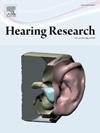Perilymph sampling in Mongolian gerbil, technical note and procedure evaluation.
IF 2.5
2区 医学
Q1 AUDIOLOGY & SPEECH-LANGUAGE PATHOLOGY
引用次数: 0
Abstract
Objective
The aim of this study is to detail and evaluate the surgical procedure for perilymph sampling from the cochlear apex in the Mongolian gerbil.
Design
Perilymph sampling from the cochlear apex was performed one to three time in 12 male gerbils aged 8 to 12 months via the submandibular route. 11 of them were previously implanted with intracochlear implants loaded with dexamethasone and placed in the scala tympani, the 12th was used to collect control samples. The procedure was performed under general gas anesthesia, with head support, by a submandibular approach. After opening the bulla and sacrificing the external and middle ears, the cochlea was exposed and perilymph sampled. Macroscopic features of perilymph samples were reported before an HPLC-MS/MS assay to detect and quantify dexamethasone. Some cochleae were then harvested, immunostained and cleared to study fibrosis formation along the labyrinth and evaluate the consequences of multiple sampling procedures.
Results
The perilymph sampling procedure was technically difficult and required experimenter training. The procedure was well tolerated by the animals. One drawback of this technique in our gerbil model was the need to sacrifice the external ear, eardrum and ossicular chain to allow sufficient exposure for a quality procedure. Our technique enabled the collection of perilymph samples of the desired volume. Most of our samples were contaminated by bleeding from the otic capsule bone secondary to the cochleostomy. Nevertheless, HPLC-MS/MS analyses which successfully found dexamethasone in the perilymph of implanted gerbils, confirmed that our method was suitable for pharmacokinetic analyses. The occurrence of areas of fibrosis in the labyrinth after a sampling procedure compromises the quality and reliability of subsequent samples from the same animal.
Conclusion
The Mongolian gerbil is an animal model that can be used to collect perilymph from the cochlear apex to perform pharmacokinetic studies. The number of samples taken from a single animal must be limited to one.
蒙古沙鼠近生殖器取样。技术说明和程序评价。
目的:研究蒙古沙鼠耳蜗尖周围淋巴取样的手术方法。设计:对12只8 - 12个月的雄性沙鼠进行一至三次耳蜗尖周围采样,通过下颌下路径。其中11只预先植入装有地塞米松的耳蜗内植入物并置于鼓室内,第12只用于收集对照样本。手术在全身气体麻醉下进行,头部支持,由下颌下入路。打开球囊,牺牲外耳和中耳后,暴露耳蜗并取样耳蜗周围。在HPLC-MS/MS检测和定量地塞米松之前,报告淋巴管周围样品的宏观特征。然后摘取一些耳蜗,进行免疫染色和清除,以研究沿迷路形成的纤维化,并评估多次采样程序的后果。结果:淋巴管周围取样程序技术难度大,需要对实验人员进行培训。动物们对这一过程耐受良好。这项技术在沙鼠模型中的一个缺点是需要牺牲外耳、鼓膜和听骨链,以便为高质量的手术提供足够的暴露。我们的技术能够收集到所需体积的淋巴管周围样本。我们的大多数样本都受到耳蜗造口术后耳囊骨出血的污染。然而,HPLC-MS/MS分析成功地在植入沙鼠的淋巴周围发现了地塞米松,证实了我们的方法适用于药代动力学分析。在采样过程后迷宫中出现纤维化区域会影响来自同一动物的后续样本的质量和可靠性。结论:沙鼠是一种可用于耳蜗尖周围淋巴采集的动物模型,可用于药物动力学研究。从一只动物身上采集的样本数量必须限制在一只。
本文章由计算机程序翻译,如有差异,请以英文原文为准。
求助全文
约1分钟内获得全文
求助全文
来源期刊

Hearing Research
医学-耳鼻喉科学
CiteScore
5.30
自引率
14.30%
发文量
163
审稿时长
75 days
期刊介绍:
The aim of the journal is to provide a forum for papers concerned with basic peripheral and central auditory mechanisms. Emphasis is on experimental and clinical studies, but theoretical and methodological papers will also be considered. The journal publishes original research papers, review and mini- review articles, rapid communications, method/protocol and perspective articles.
Papers submitted should deal with auditory anatomy, physiology, psychophysics, imaging, modeling and behavioural studies in animals and humans, as well as hearing aids and cochlear implants. Papers dealing with the vestibular system are also considered for publication. Papers on comparative aspects of hearing and on effects of drugs and environmental contaminants on hearing function will also be considered. Clinical papers will be accepted when they contribute to the understanding of normal and pathological hearing functions.
 求助内容:
求助内容: 应助结果提醒方式:
应助结果提醒方式:


